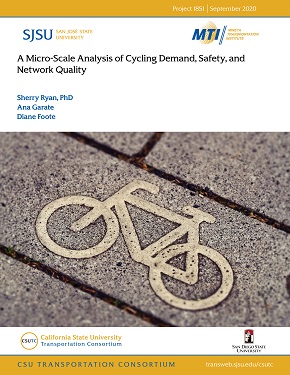- 408-924-7560
- mineta-institute@sjsu.edu
- Donate
A Micro-Scale Analysis of Cycling Demand, Safety, and Network Quality
This research uses a unique database of cycling volumes from the San Diego region to estimate cycling demand and cycling collision models. Continuous cycling count data collected from 34 automated counters are used to extrapolate over 1,400 short duration counts to average annual daily bicycle volumes (AADB). Network characteristics, built environment, and socio-economic characteristics are primary independent variables employed in the modeling. A key contribution of this research is to incorporate both a whole-network measure (betweenness centrality) and a network quality measure (LTS) in estimating cycling volumes. This research also improves upon cycling risk assessment by using more rigorous exposure measures, meaning that not only is the number of collisions at a particular location taken into consideration, but the overall cyclist volume is also considered. A final key contribution is to assess the correlation between ad hoc cycling propensity models used by practicing planners in San Diego and actual AADB. The research findings show that betweenness centrality is significant in estimating cycling volumes, meaning that as the centrality or importance of a roadway segment increases, cycling volumes also increase. It is important for long-range bicycle planners and local government traffic engineers to understand that key connections in the network draw cyclists as well as drivers and should have cycling infrastructure of adequate quality. In many instances, when connections are critical and constrained, cycling infrastructure is the first design element to be dropped. The rate of cycling collisions is found to be significantly related to proximity to freeways (higher collision rates closer to freeways), to lower income neighborhoods (higher cycling collision rates in lower income neighborhoods), and to higher density neighborhoods. In the case of San Diego’s ad hoc bicycle planning tools, this research shows that indeed, high cycling propensity is related to higher bicycle volumes. A critical policy implication of this research is that local government mobility planners should more holistically consider cycling networks in their long-range plans and short-range implementation efforts, and that network-based performance measures can be more informative than demand- based performance metrics for the cycling mode. Network-based performance metrics need to be explored more rigorously in local planning as they are easy to calculate and shown to be statistically significant predictors of cycling demand.
SHERRY RYAN, PhD
Dr. Sherry Ryan is a Professor of City Planning and the Director of the School of Public Affairs. Her research interests focus on active transportation planning, travel behavior/ land use interactions, and community health. She has published numerous journal articles on travel behavior, land use patterns, and the built environment’s effects on health. She has also served as a consultant project manager for several significant local and regional planning efforts in Southern California, Arizona, and Mexico, including the City of San Diego’s 2013 Bicycle Master Plan Update, SANDAG’s first ever regional bicycle plan in 2010, and multijurisdictional planning efforts in Guadalajara, Jalisco, and Leon, Guanajuato. She is nationally recognized for leading the development and implementation of regional active travel data collection programs in San Diego, Maricopa County, Arkansas, and Los Angeles. One of her recent projects, the City of San Diego’s Pedestrian Crossing Policy Update, received the Center for Disease Control and Prevention Excellence in Pedestrian Safety Research award in 2013.
ANA GARATE
Ana Garate is pursuing a Master of City Planning degree from San Diego State University and is currently a research assistant at SDSU’s School of Public Affairs and a planning intern with Chen Ryan Associates.
DIANE FOOTE, MCP
Diane Foote holds a Master of City Planning from San Diego State University and is currently a Research Associate on the Connecting Wildlands & Communities project, which is a State of California Strategic Growth Council funded research effort led by Rebecca Lewison, PhD.
-
Contact Us
San José State University One Washington Square, San Jose, CA 95192 Phone: 408-924-7560 Email: mineta-institute@sjsu.edu






